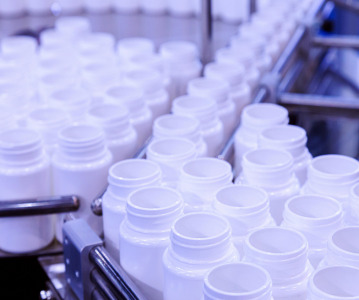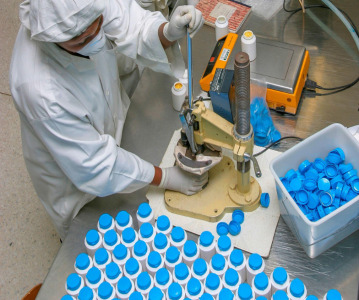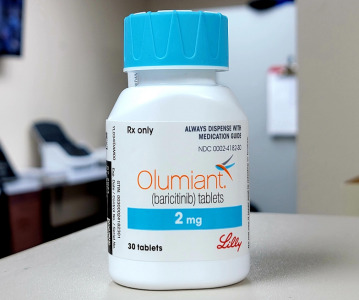The HPAPI supply chain: why manufacturers should care about handling and transportation
.png)
An increasing number of drug development pipelines are turning towards the use of HPAPIs to target rare and ‘undruggable’ diseases. In this article, we talk to leading industry experts about how pharmaceutical manufacturers are adapting and innovating to meet complex considerations for HPAPI handling and transportation and remain relevant to their pharmaceutical partners.
With advances in clinical pharmacology, oncology, and rare disease therapeutics garnering more and more interest from pharmaceutical giants across the industry, highly potent active pharmaceutical ingredients (HPAPIs) have seen a similar increase in focus. Anti-cancer therapeutics in development have particularly driven an explosive growth for the manufacturing and commercial production of HPAPIs. However, given the cytotoxicity and potency of HPAPIs, the pharmaceutical supply chain must pay considerable attention to the handling and transportation of HPAPIs, presenting new challenges for all involved.
We speak to experts throughout the pharmaceutical value chain about the significance of HPAPIs and safety considerations for handling and containing these ingredients. This article will also look at both the development and implementation of a safe and effective manufacturing process for HPAPIs to full commercial production scale, and how CMOs/CDMOs can benefit from tailoring their procedures to accommodate the needs of HPAPIs.
Highly potent and highly specific
The market for HPAPIs has seen a strong global demand in recent years as interest in targeting previously ‘undruggable’ conditions, pursuing fewer side effects, and treating chronic and rare diseases has also increased. Pharmaceutical companies are not the only players in the supply chain with such interest in HPAPIs – contract manufacturers, suppliers, and distributors are also setting their sights on incorporating HPAPIs into their business and services portfolios [ii]. Catherine Wilkes, Executive Director, Environmental, Health and Safety and Robert Alfred, Director, Environmental Health & Safety at Quotient Sciences, both expect the increase of HPAPIs present in drug development pipelines to contribute drive business interests and investments for CDMOs: “With growth in the oncology drug market expected to reach $269 billion by 2025, the need to develop and manufacture more targeted therapeutics becomes a leading driver of CDMOs to invest in containment solutions and equipment that can handle high potency development and manufacturing," they state
Sources such as the US FDA define a highly potent component as an ingredient or intermediate that has an occupational exposure limit (OEL) of less than 10 µG/m3 of air over an 8-hour time-weighted average [iii]. With such toxicity levels, special consideration must be given to the specific requirements demanded by such ingredients at each stage of delivering the final pharmaceutical product. This is to ensure the safety of the personnel involved and protection of equipment, all while maintaining product efficacy. HPAPIs are often poorly soluble or may present with bioavailability challenges, complicating containment options [iv]. Additionally, there is a lack of a universal definition for HPAPIs, limiting the data available on substances that could be classified as an HPAPI. With this lack of clinical data, the appropriate specialist requirements and risk-assessment process for handling and contain HPAPIs may differ across facilities. There may exist differences in a substance’s potency versus its toxicity (may be pharmacologically effective at a low dose, but only toxic at a high dose, or difficulties with extrapolating existing data from clinical trials to guarantee safe and proper handling for all personnel involved [v]. As a result, working with HPAPIs requires very technical knowledge and training in order to minimise the risk of working with them as much as possible.
Scott Patterson, VP Pharma/Bio Technical Support at ILC Dover, cannot understate the risks associated with HPAPIs throughout the entire pharmaceutical development, manufacturing and commercial supply chain: “When we talk about HPAPIs, we really talk about the hazard and the risks. The Hazard is how toxic the compound is itself, while the risk asks ‘what are we doing with it? What’s happening with it?’ So when you’re in the manufacturing part of the process where you may have intermediate steps and transportation between these steps, you have a certain amount of risk in filling containers, discharging, and transporting compared to regular APIs. Risk is equal to hazard plus frequency, and so it’s how much product is being handled, how it’s being transported, and so on.”
Wilkes expands on these concepts stating that “the concept of Acceptable Workplace Exposure Levels (AWELs) and OELs is based on the premise that workers who are handling material may be exposed to a defined level of chemical substances without significantly increasing the risk of adverse health effects... In recent years, a number of systems have been proposed for categorizing drug substances according to their potency, based on the use of OELs or Occupational Exposure Banding (OEB) systems.” She highlights systems such as the Performance-Based Level of Exposure Classification (PBLEC) system that work towards the establishment of controls determined by the hazard and risks posed from handling specific compounds, many of which usually do not have an established AWEL or OEL. The PBLEC system works around the concept of control strategies to give necessary guidance around containment and control of highly potent compounds. “New drugs in the early stages of development often have very little safety data available, making classification difficult for the Environmental, Health, and Safety (EHS) professional. The PBLEC guideline allows the EHS professional to categorize compounds that have very little safety data in order to estimate their toxicity,” Wilkes and Alfred explain.
With little safety data and relatively new concepts and guidance for their safe handling and transportation, what are HPAPIs bringing to the pharmaceutical industry that makes them so enticing to work with, and why should manufacturing partners care?
How HPAPIs are driving outsourced manufacturing
A large proportion of drug development pipelines are starting to focus on treating highly complex, previously ‘undruggable’ therapeutic targets. The small molecule landscape within drug development has seen an increase in the use of HPAPI molecules, currently taking over 30% of drug development pipelines [vi]. A growing interest in innovative drugs and therapeutics also accounts for this increase in interest for HPAPI molecules, with smaller pharma companies and CROs/CDMOs tailoring their development of innovative molecules and products to stay ahead of the market curve.
Pharmaceutical companies are consistently looking to collaborate with partners who can reliably work with HPAPIs. Bernard Vianes, Global Director at Indena, comments that “the general trend of pharmaceutical companies for the last few years is to outsource the production of HPAPIs and related activities, requesting important [capital expenditure] to a short list of qualified and/or preferred suppliers.” With higher entrance barriers to market than regular APIs, Vianes emphasizes the need for pharmaceutical manufacturing partners to advance their process and containment solutions to ensure safe handling and transportation during production. “The most important thing to consider is having a specific solution for a specific product,” he asserts. The specificity demanded by HPAPIs has led to such companies investing in innovative technologies for handling and transporting highly potent chemicals. The internal deactivation of waste products should be realised at the CDMO before external disposal, as well as factoring in aspects that may not be even a slight consideration when working with regular APIs.
While there remains some debate among pharmaceutical professionals as to the efficiency and security of working with a single partner or multiple across the pharmaceutical development pipeline, there has been some research to suggest that working with a single partner across this pipeline has been shown to shorten timelines and decrease risk [vi], though Vianes disagrees, citing the mitigation of risks is achieved by diversifying a company's HPAPI portfolio with several qualified CDMOs. Regardless of how many outsourced partners a pharmaceutical company decides to work with, a company looking to develop highly specific drugs and therapeutics for complex conditions will be looking for an equally specific manufacturing partner or partners. Many CDMOs thus have not only begun offering in-house expertise when working with HPAPIs, but also investing in transportation and packaging innovations that demonstrate their capabilities to safely handle HPAPIs for their customers. Such investments cement these companies in the minds of their clients developing complex therapeutics that require ingredients with precise specifications [vi].
HPAPI handling and transportation considerations in the supply chain
Manufacturers, suppliers, and distributors must evaluate the potential risks involved when handling and transporting HPAPIs and their waste products before any innovative solutions can be presented. Many experts agree that a thorough toxicological assessment for each HPAPIs is the first and most important step when working with such compounds. However, as we have seen above, sufficient data for each ingredient is not always readily available, especially, as Vianes states, for NCEs at very early stages of development. Vianes suggest that CDMOs invest in internal expertise and assessments in such cases: “The advantage comes for a CMO/CDMO through their internal expertise and capability to assess a new compound, and not to freeze the approach in the worst-case scenario, which is always a non-optimal solution economically at the commercial scale. The safety of the operators is a cornerstone for handling and transporting APIs in general, and even more so for HPAPIs. There must be training procedures in place and constantly upgraded according to major agency recommendations.”
Conducting risk assessments and implementing risk prevention strategies at the source focuses handling and transportation practices to ‘containment at the source’, as Wilkes and Alfred describe: “To handle HPAPIs safely, manufacturing practices have moved away from reliance on PPE alone, with current practices focusing on ‘containment at source’ to prevent operator exposure. This is achieved through the effective use of engineering controls (e.g. local exhaust ventilation (LEV) devices, full hard-shell or flexible containment, and closed transfer systems). The type of engineering control required is dependent on the PBLEC category of the API and the risk of operator exposure to inhalable powder particles from the manufacturing process. In addition to the primary engineering controls, to ensure containment at source, other facility designs (e.g. air change rates, high-efficiency particulate air (HEPA) filtration, airlocks) and administrative controls (e.g. safe methods of working, operator training) are employed. PPE that is appropriate to the task is also required. Containment strategies may differ slightly in the laboratory compared to the manufacturing area due to the lower quantity of API being handled (i.e. milligram compared to kilogram scale), but the same principles of operator protection are employed.”
These assessments and practices don’t stop at the manufacturing facility – attention must be given to all parts of the supply chain. As the compounds are transported from facility to facility, sometimes across borders, specific limitations regarding the transportation of HPAPIs may include:
- Idle time between transit. Vianes points out that developing so-called ‘Tarmac time’ parameters at key ports of entry can aid manufacturers in their evaluation of packaging solutions to reduce the impact of sun irradiation and temperature fluctuations on tar-based paving commonly used on airplane runways.
- Transportation of contaminated packaging. Waste material management and disposal is an important step in commercial pharma manufacturing and is even more so for HPAPIs where the waste materials are oftentimes highly potent. Not only must suppliers and manufacturers account for the disposal of these potent materials, but they must also consider the best approach for cleaning or disposing of contaminated containers. Factors to consider include cost-efficiency, timelines, and sustainable practices.
-
Sustainability of HPAPI and waste material handling and transportation. As with any pharmaceutical product, sustainability is a concern throughout the development and manufacturing pipeline. Patterson cites potential scenarios and their respective challenges when transporting HPAPIs and disposing of their waste: “There’s a great discussion that comes up about sustainability. [With FIBCs] we’re dealing with single-use plastics. If you go back to steel drums, think about all the water and detergents that are used, particularly for that first rinse of the bin. You’ll be burning 50–200 kilos of water. It’s a balance, right?”
Once specific challenges and issues related to HPAPIs and their handling have been assessed, it is then that innovation can begin. As with anything, the key to providing solutions to problems is possessing the right information early in the development process [vii]. Considering potential risks at every stage of the supply chain will maximise not only the safety of all individuals involved (something Vianes likes to refer to as the ‘Human Element’), but also cost and time efficiency of the development, manufacturing, and commercial pipelines [v].
Making HPAPI handling and transportation safer and faster
Advancements for handling and transporting HPAPIs range from technological achievements in packaging to the addition of critical data analysis and risk assessment within a CDMOs internal service offerings.
For containment of HPAPIs, Patterson expands on how FIBCs provide a specific solution for compounds that demand specificity: “When working with HPAPIs, it is a unique kind of product. How do you get the HPAPI in and out of an FIBC while still protecting the operator? You want to contain that process and it becomes part of a bigger trend of protecting the product from any kind of contamination – so having highly contained methods for transferring materials in stainless steel bins will also need to be unique (connection systems like split butterfly valves etc.). When you’re working with an FIBC, it’s just that – it's flexible. You can manipulate the wall very easily to ensure that you have flow from the FIBC into the process and so forth.” Patterson contrasts the flexibility and visibility of FIBCs with standard stainless steel bins, in which operators might have poor visibility and knowledge regarding the contents of the bin. When asked about sustainability concerns when working with single-use plastics like FIBCs, Patterson once again makes a compelling case for them in contrast to steel bins, citing the energy requirements to clean HPAPI residue and waste material from reusable bins as far more detrimental to the environment than incinerating single-use plastics. Empty stainless steel bins may even be shipped back to the original supplier, massively increasing a company’s carbon footprint at a time when pharmaceutical giants are looking to partner with those who make sustainability a priority. Accounting for such challenges has allowed Patterson’s team to develop unique FIBC mechanisms for HPAPIs.
When looking at the actual transportation of HPAPIs, Vianes’ team has similarly taken into account how the packaging must sustain the compounds through the entire transit, including the aforementioned Tarmac Time: “The goal is to secure the HPAPI when it is exposed to temperature variations on the tarmac, remaining within a range of temperatures determined from critical data analyses defined to remain stable.” Different regulations at international borders in place to protect national supply chains and security measures may also pose increased wait times at ports of entry, especially for more potent compounds. Such wait times at borders may be avoided together as Vianes highlights the advantages of securing the relevant certifications. Reduced examinations, shortened wait times at international borders, and business resumption priorities in the case of unforeseen disruptions (i.e. natural disasters etc.) are given to parties with the proper authorisation. Whether it be joining the CTPAT working with the US Customs and Border Protection or gaining full AEOF certification for trade within the EU, holding these certifications and memberships will allow a company to adhere to both customer timelines and international regulations.
Finally, both Patterson and Vianes cannot underscore the importance of the ‘Human Element’ enough – maintaining highly qualified and trained technical staff to ensure a working culture with strict adherence to health and safety policies is the cornerstone to running HPAPI operations safely and efficiently. In an industry where providing healthcare to patients is the ultimate priority, the same safeguarding must be provided to those bringing innovative therapeutics to those who need it most.
References
[ii]HPAPI Handling Protocols (sigmaaldrich.com)
[iii] DEVELOPMENT-AND-IMPLEMENTATION-OF-A-LARGE-SCALE-HPAPI-MANUFACTURING-PROCESS.pdf (researchgate.net)
[iv] Handle with Care (pharmtech.com)
[v] indena-white-paper_1808_lrs-final.pdf (informa.com)
Related News
-
News Women in Pharma: Moving beyond discussions and into best practice at CPHI Milan
In this second CPHI Milan special of our monthly series, we cover the key takeaways from the Diversity & Wellbeing track held on October 10, 2024. -
News AstraZeneca invests in AI collaboration for cancer drug trials
The British-Swedish pharmaceutical giant is partnering with biotechnology firm Immunai Inc to increase the efficiency of some cancer drug trials. -
News Ozempic and Wegovy prices questioned as Novo Nordisk faces US Senate hearing
The CEO of Novo Nordisk was grilled during a US Senate committee hearing on September 24, 2024, in which the exorbitant prices of the Danish company’s blockbuster drugs Ozempic and Wegovy were called into question. -
News The BIOSECURE Act: implications for the pharma supply chain
On September 9, 2024, the US House of Representatives voted to pass the bill titled the BIOSECURE Act (the Act), which lists several Chinese companies in the pharmaceutical supply chain. The Act will prohibit American companies from contracting or doin... -
News On Track at CPHI Milan: Thermo Fisher Scientific Track Sponsor interview
With CPHI Milan just around the corner, we sat down with some of the sponsors for this year’s conference tracks to discuss the most pressing topics in pharma. -
News CPHI Milan Speaker Spotlight: Pharma Manufacturing and Localisation in Africa
In the run-up to CPHI Milan, we sit down with some of the experts and thought-leaders speaking at this year’s conferences. -
News US BIOSECURE Act passed by US House of Representatives
The controversial act, which has already impacted several foreign companies operating in the US, was passed by the House of Representatives on September 9, 2024. It is now headed for the US Senate before it can be signed into law by President Joe Biden... -
News Eli Lilly licenses rheumatoid arthritis manufacturing in Africa
American pharmaceutical company Eli Lilly has signed a partnership with Egyptian organisation Eva Pharma to localise manufacturing of rheumatoid arthritis treatments in Africa.
Position your company at the heart of the global Pharma industry with a CPHI Online membership
-
Your products and solutions visible to thousands of visitors within the largest Pharma marketplace
-
Generate high-quality, engaged leads for your business, all year round
-
Promote your business as the industry’s thought-leader by hosting your reports, brochures and videos within your profile
-
Your company’s profile boosted at all participating CPHI events
-
An easy-to-use platform with a detailed dashboard showing your leads and performance

.png)





